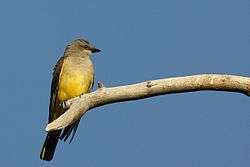Cassin's kingbird
| Cassin's kingbird | |
|---|---|
 | |
| Scientific classification | |
| Kingdom: | Animalia |
| Phylum: | Chordata |
| Class: | Aves |
| Order: | Passeriformes |
| Family: | Tyrannidae |
| Genus: | Tyrannus |
| Species: | T. vociferans |
| Binomial name | |
| Tyrannus vociferans (Swainson, 1826) | |
Cassin's kingbird (Tyrannus vociferans) is a large tyrant flycatcher native to western North America. The name of this bird commemorates the American ornithologist John Cassin.
Description
Adults have a gray head with slightly darker cheeks; a dark unforked tail with a buffy fringe and gray-olive underparts. They have a pale throat and deep yellow lower breast.
Juveniles are duller and have pale edges on their wings.
Similar species

Cassin's kingbird and the western kingbird are similar in appearance. Cassin's is a little larger than the western and the upper parts are a darker gray than the western. The most distinctive difference between the birds is that the Cassin's has a thin white strip along lower edge of the tail feathers and the western has a thin white strip that runs along the edge of the tail feathers.[2] This difference can be seen in the image on the left.
Distribution and habitat

In the summer, these birds can be found in California and from Montana to Utah, along the eastern Rocky Mountains. Their habitat includes rangelands and savannas.
These birds migrate to their winter quarters between Southern California and northern Central America. They are permanent residents in south-central Mexico, and their main wintering ranges are west of the Gulf of California on Baja California Sur, and east of the sea on the mainland of western Mexico.
Behavior
They build a bulky nest on a horizontal tree limb in mid-story or the canopy of trees. The three to five spotted white eggs have an incubation period of 18 to 19 days.
The Cassin's kingbird primarily feeds on insects it preys upon from high perches by hawking. It also eats berries and fruits in lesser quantities.
The call is a high-pitched shorter followed by a longer chirp, sounding like chi-beer.
Mating ritual
In early spring, presumably after having chosen (or shown up with) their mate, they launch into a peculiar dance. With excited high-pitched calls, they hover in unison, wings outstretched, over a favorite perch. This dance takes place several times a day over several days, over several separate sites in an area covering 2 to 3 acres (8,100 to 12,100 m2). The sites chosen for the dance appear to be the same sites used as hunting perches during the spring and summer.
References
- ↑ BirdLife International (2012). "Tyrannus vociferans". IUCN Red List of Threatened Species. Version 2013.2. International Union for Conservation of Nature. Retrieved 26 November 2013.
- ↑ The National Geographic Field Guide to the Birds of North America, 4th edition, page 298
External links
| Wikimedia Commons has media related to Cassin's kingbird. |
| Wikispecies has information related to: Tyrannus vociferans |
- Cassin's kingbird photo gallery at VIREO (Drexel University)
- Photo of Cassin's kingbird at Coal Oil Point Reserve - UCNRS.org
- Tyrannus vociferans in the CalPhotos Photo Database, University of California, Berkeley
- "Cassin's kingbird media". Internet Bird Collection.
- Interactive range map of Tyrannus vociferans at IUCN Red List maps
